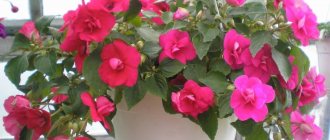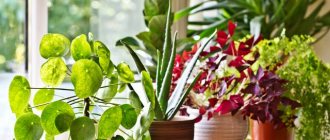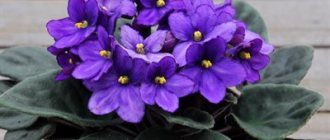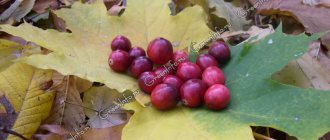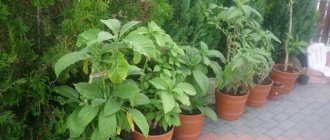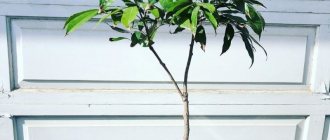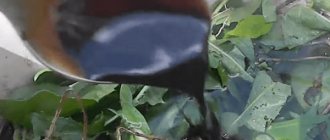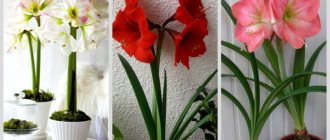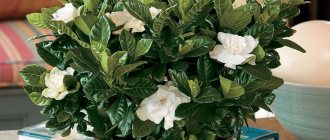The best way to create coziness and beauty in your home is to decorate it with living plants. Indoor flowers blooming all year round on the windowsill, turning even a modest home into a bright, lush oasis. The healing properties of green spaces are confirmed by scientists all over the world. They saturate the air with oxygen, neutralize harmful radiation, protect against colds and depression, and simply give joy.
The modern world of indoor flowers is extremely diverse. Conventionally, they can be divided into two groups: unpretentious, capable of blooming in dry and shaded rooms, and capricious, demanding of light and watering.
Geranium
In the photo - indoor geranium
Indoor geranium or pelargonium is known as “grandmother’s” home flower, a symbol of comfort. It tolerates dry air and lack of moisture very well. Its place is on the south window, where there is a lot of sun and warmth. In the shade, the stems stretch upward, and dense bright red and pink-white caps rise above the lush green foliage. Geranium blooms long and luxuriantly, while repelling insects and purifying the air of pathogenic microbes.
It is not recommended to place the flower next to the bed.
Recommendations for cultivation
In order for such flowers to grow and develop, and also to delight household members with their lush blooms, they require full lighting - lack of light is one of the most common reasons for the absence of flower stalks. Daylight hours must be at least 10 hours, so additional lighting will be required in winter.
It is very important to choose the right soil mixture. A lack or, on the contrary, an excess of nutrition has a detrimental effect on flowering - when applying fertilizing, you must strictly follow the manufacturer’s instructions on the packaging of the drug
The flowering process is influenced by a number of factors. Among them:
- quite high temperature;
- increased air humidity;
- proper irrigation regime.
In conclusion, we note that now many people prefer to buy already flowering plants in stores. On the one hand, this allows you to enjoy the beauty without any effort, on the other hand, these plants were grown with the addition of a huge amount of special fertilizers.
Begonia
In the photo - ever-blooming begonia
A fabulous “scarlet flower” on the windowsill. The beautifully blooming gifts of the flora amaze with their variety of shades: from apricot lace and yellow fringe to pearl white and peach tones. Luxurious, double flowers reach a diameter of 6-8 cm. Begonia is placed in a well-lit place, but it is better if it is diffused light. In winter, additional lighting is required. Begonia is moisture-loving. In extreme heat, the soil should be moistened daily, and in the cold season, watering should be reduced to a minimum.
Phalaenopsis or butterfly orchid
The most resilient orchid in cultivation with large flowers of various colors. A characteristic feature is monopodial growth - their stem does not branch, but slowly grows in length, producing 1–2 leaves annually. Currently, thousands of cultivars have been bred, characterized by abundant, long-lasting flowering, large flower sizes (up to 10 cm in diameter) and beautiful colors - white, pink, carmine, with bright specks or stripes.
Phalaenopsis orchid in the apartment
Phalaenopsis are very easy to grow, they need:
- Bright, diffused lighting: eastern, western windows.
- Temperature +25, not lower than +15 °C. Lower night temperatures stimulate the formation of flower buds.
- In winter, additional lighting is useful.
- During the growing season in the summer months, daily misting is recommended.
- A special substrate is required for orchids; ordinary soil is not suitable for them. And special transparent plastic pots in which you can make drainage holes.
Simple rules for caring for phalaenopsis
Dividing an orchid - phalaenopsis: master class with photos and videos
Replanting a newly purchased orchid: master class on replanting phalaenopsis
Kalanchoe
In the photo - Kalanchoe
A newcomer from the distant and hot Madagascar, Kalanchoe is considered one of the most unassuming. Accustomed to hot climates and dry soil, the tropical guest can go without watering for a long time. On the contrary, excess moisture is extremely undesirable, and watering it once a month is sufficient. It is necessary to distinguish between medicinal and decorative varieties. Flower growers choose blooming Kalanchoe, all covered with small, bright flowers, pleasing to the eye during the cold winter months.
Decembrist
Decembrist white
The name speaks for itself. Possessing a persistent, “Nordic” character, the Decembrist lives up to 20 years and in the bitterest frosts amazes with the brightness of its colors. Pink, purple, yellow, crimson inflorescences have an unusual shape with curly curls and delicate long stamens. Spreading bushes with hanging clusters turn the windowsill into a blooming winter garden.
Primrose
Primrose indoor
Happiness is on the window. A beautiful indoor flower is rightly called a living antidepressant. It's hard to take your eyes off the stunning heavenly, amethyst or lush carmine-red petals. It is demanding of warmth and light, but does not like direct sunlight. The plant is best placed on the north and west sides. Low temperatures are not scary for him; on the contrary, 16-20° is quite enough. Water the primrose carefully, trying not to get it on the foliage as the soil dries. Spraying is excluded. To prevent water from stagnating, drainage should be provided.
Pelargonium
The flowers are larger than those of geraniums. They are red, white, and crimson in color. There is almost no smell of the leaves. Pelargonium should be watered abundantly in summer and moderately in winter. For year-round flowering, the plant should be kept in well-lit places, but not in direct sunlight. In spring, it is recommended to prune pelargonium to give the bush its shape.
Anthurium
Anthurium
An elegant aristocrat with leaves covered with decorative patterns and as if smeared with wax. Small flowers are collected in a yellow “cob” and surrounded by a bract - a scarlet, snow-white or lilac veil. Anthurium is shade-tolerant, can bloom for 2-3 months in a row, and cut flowering stems remain fresh for several weeks. Place it on a western or eastern window, avoiding direct sun. However, on short winter days additional artificial lighting is required. Drafts and temperature changes are excluded. Water moderately, making sure that the soil has time to dry. Use soft, settled water.
Abutilone
This plant is also known as indoor maple. Ask why? Its leaves are shaped like maple leaves. Abutilon blooms at the very beginning of spring and stops throwing out buds only in winter. If you provide the indoor maple with a long daily period of lighting and regular watering, then it will bloom even in winter, without hibernating.
Applying nutritious fertilizer will help restore the strength the plant needs to lay new buds.
Spathiphyllum
Spathiphyllum
The complexity of the name is compensated by the ease of care. Ideal for beginner gardeners. Spathiphyllum tolerates long periods of lack of moisture and lack of sun. Snow-white sails on a green background resemble calla lilies in a wedding bouquet. They delight owners all year round, but bloom especially wildly in the summer.
Euphorbia Mile
An original, beautiful flower in its own way. It belongs to the genus of succulents. Like all cacti, milkweed has small spines that are located throughout the stem. During flowering, the plant is strewn with small but bright red flowers.
If you give this plant a place on the windowsill, it will delight you with its flowering all year round. He makes no further demands on care. And it will withstand even dry soil and lack of moisture for 2 weeks. This will not affect its appearance or flowering at all.
Experienced gardeners have noticed one more detail - a tight pot stimulates spurge to bloom profusely.
Balsam
Balzin or “Vanka wet”
Better known as “Vanka wet”. It grows well even in the shade and loves water very much. Resistant to dry air, balsam grows well in any conditions, including kitchens and cool northern windows. The spreading, lush bush is literally strewn with small flowers, similar to roses, camellia or double carnations, depending on the variety.
Chinese rose
Hibiscus Gabriel
The correct name is hibiscus. A magnificent beauty with large, fiery red, satin white or sunny orange inflorescences. The buds open one after another, live only one day, dry out, and new petals immediately bloom in their place. It gives the impression of constant flowering. Among indoor plants that bloom all year round, hibiscus is one of the most spectacular. In the summer season it is watered in the morning and evening. The plant is light-loving, grows quickly and needs space. To give shape and slow down growth, the tops are periodically trimmed.
Features of frequently flowering indoor plants
Among domestic flowers there are many representatives of subtropical and desert flora. They need several weeks or months of rest throughout the year. The rest coincides in time and duration with the period of drought in the plant’s homeland. Therefore, they bloom once or twice a year, the rest of the time they grow shoots and leaves or hibernate.
In the tropics, the growing season can last all year, so houseplants - native to tropical countries - bloom all year or for 6-10 months.
Whether a houseplant will bloom spectacularly, profusely and for a long time also depends on the type and variety, choice of location, and care.
For a brief description of beautifully and long-flowering indoor plants, see the table, which presents both easy-to-care and rather demanding indoor flowers.
| Houseplant name | Peculiarities | Flowering time |
| Abutilone | Large bell-shaped or cupped flowers: white, yellow, or red-orange with yellow stamens. | From March to November |
| Akalifa | Small flowers are collected in fluffy red inflorescences that look like long earrings. | From March to October, in a bright location - almost all year round |
| Anthurium | Beautiful bracts around the inflorescence spadix. | All year round |
| Balsam | The flowers are numerous, solitary, and have long curved spurs. The petals are bright pink, scarlet or orange. | For a long time, almost the whole year |
| Beloperone | Inflorescences in orange, yellow, red, pink tones are collected at the ends of the shoots in a dense bunch. | From February to November or almost all year |
| Begonia | The flowers are simple or double, round in shape, soft pink, orange, red, yellow or white. | From April to September or continuously almost all year round |
| Geranium/ Pelargonium | Flowers of different types and varieties differ in color and number of petals, collected in large hemispherical umbrellas. | From May to September or all year round |
| Hibiscus/ Chinese rose | The flowers are large - from 10 to 15 cm in diameter, simple, semi-double or double. The color of the petals is red, orange, pink, yellow, white. | From February to October |
| Koleriya | The buds are orange-red, shaped like an elongated bell, hanging on flexible shoots or rising from the axils of the upper leaves. | From 6 months to a year |
| Kalanchoe | Flowers appear in dense corymbose inflorescences. The color of the petals is bright red, bright yellow, light orange, white, pink, purple. | All year round |
| Pachistachis | Small white flowers emerge from bright yellow, orange or pink bracts. After flowering, attractive golden buds remain. | Six months, from spring to autumn |
| Ruellia | The leaves are velvety, abundantly branched shoots, delicate five-petaled flowers. | From October to December |
| Violet / Saintpaulia violetflower | Leaves with tomentose pubescence, flowers are simple, semi-double or double, petals are straight, wavy and fringed. The color of the flowers is violet, lilac, blue, light blue, purple, cherry, crimson, pink, white. | All year round |
| Spathiphyllum | Shiny leaves and inflorescence-cob with a veil. | From March to September |
| Phalaenopsis | Leathery, ovate-shaped leaves. The color of the flowers is white, cream, yellow, orange, violet, purple. | At any time of the year, several times a year. Peak flowering is in spring. |
| Cyclamen | The original shaped flowers are white, pink or red, with smooth edges or fringed. | From August-September to April Persian and all summer European. |
For indoor flowers purchased from a store or nursery, it is necessary to create conditions reminiscent of a greenhouse or greenhouse. If you immediately place the purchased plant on the window sill in the room, it will stop blooming, stretch out, or dry out.
When choosing a place for beautiful flowering plants, you should also remember that they do not like changes in lighting. Therefore, it is better not to move or rotate the pots until after flowering.
Violet
Variegated violet
Constantly blooming violets are a favorite of women. At floristic exhibitions, even people far from floriculture do not remain indifferent to the beauty of inflorescences. The petals surprise with their variety of shapes: simple, terry, corrugated, star-shaped, edged. The color range ranges from delicate lilac to thick violet. To admire the flowering for as long as possible, it should be borne in mind that violets love light, but can die in direct sunlight. It is enough to water it 2-3 times a month with warm, slightly acidified water, avoiding moisture on the foliage and rosette.
Stimulating flowering
Bright light is required for bud formation and flower development. Therefore, flowering species need good lighting more than decorative deciduous ones. Even clean window glass reflects and absorbs up to 50% of daylight.
If we compare indoor plants with outdoor ones, the former, being 2 m from the window, receive only 10% of the light that the latter receives. Many plants need additional lighting in late autumn and winter to bloom.
Indoor flowers for windows of various orientations:
- Southern: pelargonium, hibiscus, violet (with shading at midday).
- Western: bromeliad, begonia, camellia, hibiscus, indoor chrysanthemum.
- Oriental: pelargonium, violet, hibiscus, indoor chrysanthemum, begonia, Kalanchoe.
- Northern: few are reconciled, because the sun's rays almost do not penetrate the window sills of northern windows.
Flowers do not appear on the shoots at the same time. It is recommended to remove drying corollas. They not only reduce the aesthetic perception of the plant, but also prevent the development of new buds. Scissors used to trim wilted flowers must first be wiped with alcohol.
It often happens that the plant has all the conditions for flowering, but there are no buds. You can use phytohormones, biostimulants and fertilizers to activate dormant flower buds. Plants that need to bloom should not be overfed with nitrogen fertilizers. They cause the growth of vegetative organs to the detriment of generative ones - flowers, fruits and seeds.
Fuchsia
In the photo - ampelous fuchsia
The delicate beauty of fuchsia flowers, hanging in luxurious clusters and looking like bells, is touching. For rapid growth and abundant flowering, you need to observe the temperature regime, and do not neglect frequent watering and spraying of the leaves during the hot season. In winter, the need for hydration is reduced. Fuchsia needs a diffused lacy shadow. At the same time, when there is insufficient light, the stems elongate. To prevent this from happening, pinch the tops from time to time. It requires little maintenance, but there is so much beauty in these lilac, pinkish, violet inflorescences! There are varieties with two and three-color petals.
Hibiscus
This flower has the appearance of a shrub; in indoor conditions it can easily grow up to 2 m in height. Timely pruning leads to the appearance of new shoots and the formation of a lush bush.
Hibiscus, or Chinese rose in other words, is not picky about lighting. But it has been noticed that in a bright place this plant regularly produces many buds. Hibiscus flowers are large, there are varieties with double inflorescences. It’s a pity that a blossoming flower only lives for a day; the next day it falls. But almost immediately a new ovary appears in its place.
What is important for Chinese roses is regular, abundant watering. Drying of the soil leads to the cessation of the formation of flower ovaries and the falling of buds.
